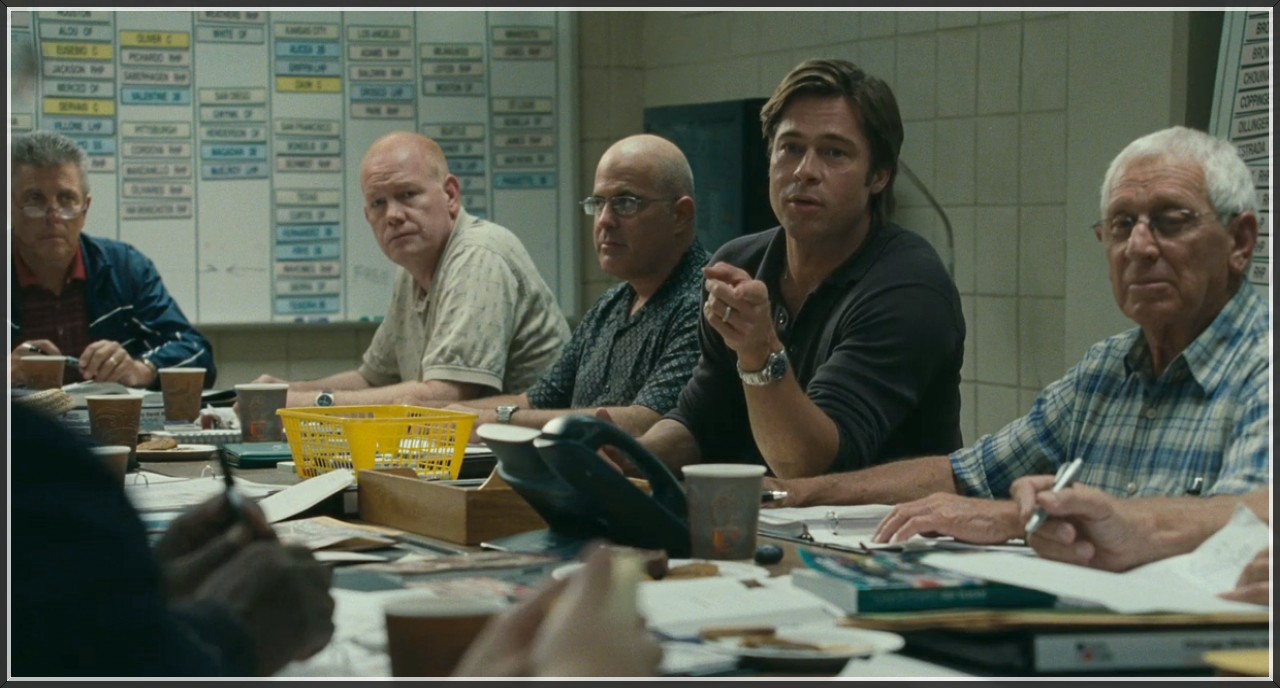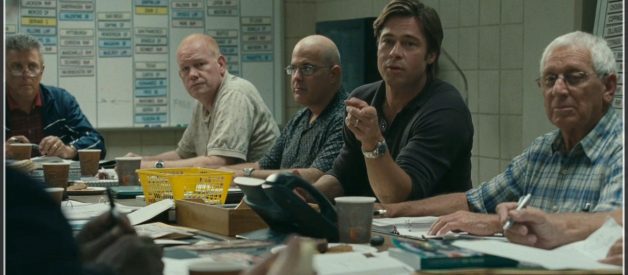 Image from razorgator.com
Image from razorgator.com
In the Moneyball movie, Oakland Athletic?s General manager Billy Beane is upset by his team?s loss to New York Yankees in the elimination round of 2001 season. He sincerely wanted to win the championship. Another sad news is that Oakland Athletics is losing three of his star players ? Damon, Giambi and Isringhausen to rival teams.
The next challenge, Billy Beane had was to assemble a competitive team for 2002 season with a measly budget of $38million compared to New York Yankees? budget of $120 million to spend on recruiting players. Billy had to find a solution.
In this scenario, due to anchoring bias, some people from the top management had framed the problem faced by Oakland Athletics as ?how to find replacements for the guys we lost, with the money that we do have?.
Later, in one of the scenes, in Oakland Athletic?s Scouting room ? Billy Beane and 10 older men(selectors and the senior management team), all former players is sitting around a larger table, were discussing the problems and trying to find solutions.
One of the former players, Grady, ?Ok.Guys. We have got three big holes to fill?.we will go around the room. I like the player Geronimo. How about him?
We could see how the selection panel is anchoring their discussions around the way the problem is framed -filling the spots vacated by the players.
As the selection members continue to discuss new players, Billy Beane becomes restless and shows his disgust. One of the selection members asks Billy?s suggestion.
Grady: We are trying to solve the problem.
Billy: You?re not looking at the problem.
Grady: We?re very aware of the problem.
Billy: Okay, good. What?s the problem?
Grady: Look, Billy, we all understand what the problem is. We have to ?
Billy: Okay, good. What?s the problem?
Grady: We have to replace three key players in our lineup.
Billy: Nope. What?s the problem?
Another selector, Pittaro: We gotta replace these guys with what we have ?
Billy: No. What?s the problem, Barry? The problem we?re trying to solve is that there are rich teams and there are poor teams, then there are 50 feet of crap, and then there?s us. It?s an unfair game.
Billy Continues: We are like organ donor for the rich. Boston has taken out our kidneys, Yankees have taken out our heart and you guys are sitting around here talking about the same old nonsense. We have to win the championship.
We could see that the problem-solving team was behind the wrong problem(the problem framed in the wrong way) and their subsequent thoughts and judgements were influenced by the same.
HEURISTICS
Decision-making is an inherently complex process that involves a significant amount of cognitive effort. If a rational mind has to get involved in making a decision, it would consume a lot of energy in performing those cognitive tasks because of the ?working memory? limitations. This would impart a feeling of fatigue. In other words, our ?mind system? is naturally against rational decisions.
To counter this fatigue, the human mind has evolved over aeons to automate a lot of behaviours and use a lot of mental shortcuts as much as possible, in responding to various scenarios. These mental shortcuts are called ?Heuristics? which our automatic, intuitive mind use to influence our decisions.
Sometimes, these heuristics help us but many times it would prove fatal. It had resulted in bad decisions and was particularly responsible for many business failures.
Some of the driving elements behind those mental ?heuristics? in our intuitive mind are our own hidden beliefs & prejudices(Cognitive Biases), which are shaped by past experiences and the environment in which a person grew up.
What makes all these ?heuristics? so dangerous is their invisibility to the decision-maker. We fail to see or recognize them.
?Sometimes the fault lies not in the decision-making process but rather in the mind of decision maker? -John S. Hammond
Framing Bias is one of the main heuristics that influence decision-making and has the potential to wreck the businesses.
FRAMING BIAS
Framing bias is a type of cognitive bias where people were forced to decide based on the way the information is presented.
Melissa Raffoni, in an HBR article, writes, ?What exactly does it mean to ?frame? or ?reframe? an issue? Think about the metaphor behind the concept. A frame focuses attention on the painting it surrounds. Different frames draw out different aspects of the work. Putting a painting in a red frame brings out the red in the work; putting the same painting in a blue frame brings out the blue. How someone frames an issue influences how others see it and focus their attention on particular aspects of it. Framing is the essence of targeting communication to a specific audience?.
Framing the Problem
The first step in any decision-making process is framing the problem in the right way as it can influence the choices we make.
Why framing the problem the right way is important? Because one of the mental shortcuts(heuristics) our human brains use is to rely too heavily on the first piece of information received(the ?anchor?) while making decisions. It gives disproportionate weight to be initial data.
Framing Bias is not just confined to the ?problem definition? but prevalent widely in many situations affecting our decision-making ability. Let?s see some examples.
FRAMING AS GAIN vs LOSS
Below is the detail of an experiment carried out by Daniel Kahneman and Amos Tversky.
A group of insurance professionals were charged with minimizing the loss of cargo on three insured barges that sank off the coast of Alaska. Each barge holds $200,000 worth of Cargo which will be lost if not salvaged within 72 hours.
Case 01 -They were given two options with identical costs.
- Plan A: This plan will save the cargo of one of the three barges, worth $200,000.
- Plan B: It has one-third probability of saving the cargo on all three barges worth $600,000, but a two-thirds probability of saving nothing.
As expected, seventy-one Percentage of respondents chose less risky plan A.
Case 02 -Then, Kahneman and Amos Tversky chose another group of insurance professionals and gave them different options.
- Plan C: This plan will result in the loss of two of the three cargoes, worth $400,000.
- Plan D: This plan has a two-thirds probability of resulting in the loss of all three cargoes but has a one-third probability of saving all the cargo of the entire $600,000.
This time though the 80% of respondents preferred plan D though it was similar to Plan B except for the way it is framed.
$200,000 gain vs $400,000 loss -Though both the plans were similar, the framing the option by ?loss? influenced the people?s decisions. This is because by nature we focus on what we may lose than what we may gain. Our aversion to loss is a strong emotion.
This also shows that people tend to avoid risk when a ?gain value? is presented but seek risks when a ?loss value? is presented.
FRAMING THE DEFAULT CHOICE
An example by John S. Hammond –
In New Jersey, 80% chose ?limited right to sue? while taking automobile insurance and in Pennsylvania, only 25% chose it. Why this anomaly?
When checked, it came to light that the two states framed the default choice in a different way.
In New Jersey, the driver automatically got the limited right to sue unless he or she specified otherwise and in Pennsylvania, the driver automatically got the full right to sue unless he or she specified otherwise.
As we know that humans would naturally prefer to stick to the status quo, most of the consumers chose the default choice. Different frames established a different status quo.
FRAMING WITH DIFFERENT REFERENCE POINTS
Another example by John S. Hammond –
Imagine you have $2000 in your checking account.
- Would you accept a fifty-fifty chance of either losing $300 or winning $500?
Many people refused the above offer.
Now, framing differently
2)Would you accept a fifty-fifty chance of having either $1700 or $2500 in your account?
This time, many people accepted the offer though both are the same. Here, the framing bias activated the mind?s contrast bias or relativity bias(Another mental shortcut). $2500-$1700=$800 appears higher and profitable than $500-$300=$200. The different reference points played the role.
We always look at our decisions in a relative way and compare them locally to the available alternative. In the earlier case, the difference was between 300 & 500(the alternative) and in the latter case, it was between 1700 & 2500. We see a higher relative advantage in the latter case.
In the above examples, we could see how people chose different plans when framed differently. This shows that most of us tend to adopt the frame as it is presented to us rather than restating the problem in a different way.
FRAMING POSITIVE vs NEGATIVE
A 99% fat-free product or a product with only 1% fat. People preferred ?99% fat-free? framed product than the other one though both are the same.
Another example from Daniel Kahneman
Imagine you have a health problem and the doctor suggests an operation. You would like to understand whether the Doctor could be relied upon for the surgery. You receive the following framed answers.
- Out of 100 patients who had this operation, ninety are still alive even after five years.
This gives a positive view of the doctor and many were comfortable to choose this doctor.
Now to the negative framing –
2. Out of 100 patients who had this operation, ten were dead before the end of five years.
Not many were willing to choose this doctor.
Positive and Negative Framing In Business
An example from Claude Hopkins
In the early 1900s, a sales manager approached the Advertising Guru Claude Hopkins for marketing a toilet soap made up of Palm and Olive Oils. Hopkins studied the market. Every competitor was promoting its toilet soaps through negatively framed messages.
Pears targeted the problems of wrinkles if the consumer failed to buy its soap.
?No girl can afford to risk perspiration odour. Men cannot stand it!? framed by Cashmere Bouquet soap.
When everyone was framing negative messages, Hopkins framed a positive message. He wrote, ?All the world loves natural beauty. You can gain it in this simple way? using this product. This product has brought the enticement of a fresh clear skin to thousands?.
The competitors projected an image of a consumer obtaining a loss by not purchasing their product whereas Hopkins shared an image of a consumer obtaining gain by purchasing his product.
FRAMING AS THREAT OR OPPORTUNITY
In the initial years, Netflix was struggling to garner mainstream customers and many of them were still renting DVDs at Blockbuster. Netflix?s brand awareness was also so low among the common masses. Hastings thought that one way to grab attention was to project a David-Goliath image by targetting Blockbuster as it was a well-known name by then. Netflix had 300,000 subscribers compared to 20 million Blockbuster subscribers. In every interview and advertisements, Hastings and his team took swipes at Blockbuster. Hastings wanted Blockbuster to simply acknowledge a potential threat from Netflix as it would create brand awareness in the minds of consumers. But Netflix gained another benefit too.
The Threat Rigidity -Cognitive and Social psychologists have noted that if you frame a phenomenon to an individual or a group as a threat, it elicits a fear that would result in more intense and energetic response than if you frame the same phenomenon as an opportunity. If they encounter a threat, a response called ?threat rigidity? sets in and they cease being flexible and become focussed on countering the threat in order to survive. -From ?The Innovator?s Solution?.
As Hastings and his team continuously projected Netflix as a threat to Blockbuster, media too followed the same script. Unfortunately, Blockbuster too fell into the trap, saw online DVD rental as a threat to its established, robust brick-and-mortar sales and tried to protect its customers. As Blockbuster considered it as a threat, the company did not see a necessity to invest in online DVD rental. Only after three years, Blockbuster realised their mistake, began to consider it as an opportunity and committed resources. But by that time, Netflix had already got a massive head-start. Blockbuster missed the growth opportunity which eventually led to its destruction.
How to overcome Framing Bias?
- The first thing is not to automatically accept the initial frame of problem or message.
- Try to reframe the message or the problem.
The Slow Elevator -One common example of reframing which most of us would have heard ? An old multi-storied office building with an old and slow elevator. Everyone was complaining about how it takes a longer time to reach their floor.
Somebody framed the problem as ?How to increase the speed of the elevator??. Then the suggestion they got was to change any parts like motor, pulley, rope to make it faster or install a new elevator itself. Unfortunately, they had budget constraints.
One guy reframed the problem -People are irritated because of the long waiting time. He reframed it as ?How to engage the users?? -This prompted the team to install mirrors inside the elevator, place a couple of newspapers, magazines -Install a small TV with a news section. They staggered the timings of the different departments to reduce the peak hour crowd. They got simple solutions once they reframed the problem differently.
IKEA -A few years back, IKEA was facing problem in the shortage of manpower for their stores. Being a low-cost furniture manufacturer, they had their own limitations. Customers were frustrated for waiting to get the ordered furniture from the warehouse. IKEA changed the problem from ?Scarcity of employees? to ?Idle time of Customers?. Customers were frustrated ? they were waiting and idle. Can we engage them? How to engage them ? Radio, Magazines ? or, Can we ask them to go and pick up the furniture from the warehouse? And thus, IKEA?s legendary business model ?Customer?s Self Pickup? is born.
- If the message is framed positive then reframe it negatively -If it is framed as a gain, reframe it as a loss.
- Reframe the problem from different reference points.
- Reframe the problem in the reversal direction.
- One of the ways to escape Framing Bias is to understand that other people will not see the problem from the same perspective as we do. So, seek out different perspectives on the problem. This would help you to reframe the problem.
- Another way is to think the message from an outsider?s perspective.
- Have people around who would challenge your thinking. Encourage disagreements. Research shows that CEOs made fewer mistakes when they had people around them who were more likely to challenge their thoughts, perspectives and actions.
CONCLUSION
Many other heuristics play a major role in influencing our decisions and the choices we make. Sometimes they all work together, amplifying the errors in the decision. Most of our decisions are prone to these biases. The first step in protecting our decisions is to be aware of the various cognitive biases that reside in our brain.
Forewarned Is Forearmed -John S Hammond.
References: The Hidden Traps in Decision Making ? HBR article by John S. Hammond, Ralph L.Keeney, Howard Raiffa, Thinking Fast and Slow by Daniel Kahneman, The Art Of Thinking Clearly by Rolf Dobelli, Only The Paranoid Survive by Andrew S Grove.
AVAILABLE ON AMAZON –
21 KEYS to SUCCESS in BUSINESS -A Guide for Every ASPIRING ENTREPRENEUR by Shah Mohammed M.


